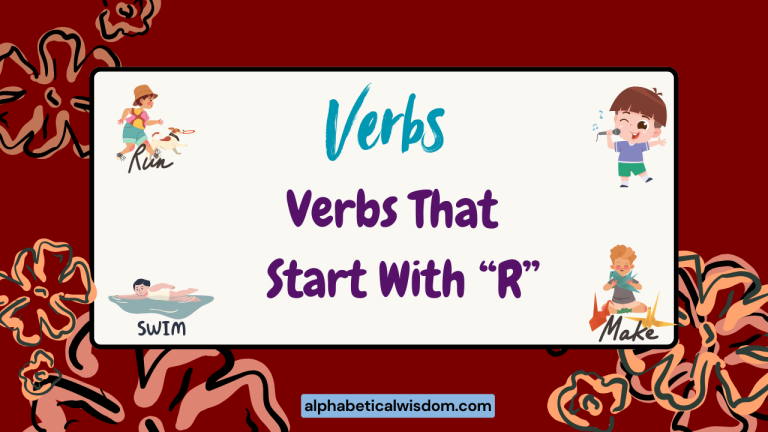Verbs Starting With D: Comprehensive Guide to Usage & Examples
Verbs are the action words of the English language, and mastering their usage is crucial for effective communication. This article focuses on verbs that start with the letter “D,” providing a comprehensive exploration of their meanings, forms, and applications.
Understanding these verbs will enhance your vocabulary, improve your writing, and make your speech more precise. This guide is tailored for English language learners, students, and anyone looking to refine their grammar skills.
Table of Contents
- Introduction
- Definition of Verbs Starting With D
- Structural Breakdown of Verbs Starting With D
- Types and Categories of Verbs Starting With D
- Examples of Verbs Starting With D
- Usage Rules for Verbs Starting With D
- Common Mistakes with Verbs Starting With D
- Practice Exercises
- Advanced Topics
- Frequently Asked Questions
- Conclusion
Definition of Verbs Starting With D
Verbs starting with the letter “D” encompass a wide range of actions, states, and occurrences. They function as the core of a sentence’s predicate, indicating what the subject does, is, or experiences.
These verbs can be classified based on their function (action, state, or auxiliary), their transitivity (transitive or intransitive), and their regularity (regular or irregular). Understanding these classifications is essential for using them correctly in different contexts.
A verb, in general, is a word that describes an action, occurrence, or state of being. Verbs are crucial for forming sentences and expressing complete thoughts.
They provide information about what the subject of the sentence is doing or experiencing. Verbs starting with “D” are no exception and contribute significantly to the richness and versatility of the English language.
Structural Breakdown of Verbs Starting With D
The structural breakdown of verbs starting with “D” involves understanding their various forms and how they change based on tense, aspect, and mood. Regular verbs follow a predictable pattern, adding “-ed” to form the past tense and past participle (e.g., decide becomes decided). Irregular verbs, however, have unique forms that must be memorized (e.g., do becomes did and done). Furthermore, verbs can be used in different tenses (present, past, future) and aspects (simple, continuous, perfect) to convey specific nuances of time and duration.
Understanding the base form, past simple, and past participle is fundamental. Additionally, consider how these verbs are conjugated with different subjects (I, you, he/she/it, we, they) and auxiliary verbs (be, have, do) to form various tenses and moods.
Recognizing these patterns will significantly improve your ability to use verbs starting with “D” accurately and effectively.
Types and Categories of Verbs Starting With D
Dynamic Verbs
Dynamic verbs, also known as action verbs, describe actions that have a beginning and an end. These verbs often involve movement, change, or activity. They can be used in both simple and continuous tenses, depending on whether the action is completed or ongoing. Examples of dynamic verbs starting with “D” include dance, draw, drive, dig, and develop.
Stative Verbs
Stative verbs describe states of being, thoughts, emotions, or senses. They typically do not describe actions that are in progress and are therefore not usually used in continuous tenses. Examples of stative verbs starting with “D” include desire, doubt, depend, detest, and dislike. However, some stative verbs can be used dynamically in certain contexts, often with a change in meaning.
Transitive Verbs
Transitive verbs require a direct object to complete their meaning. The direct object is the noun or pronoun that receives the action of the verb. Examples of transitive verbs starting with “D” include deliver (deliver the package), design (design a website), describe (describe the scene), destroy (destroy the city), and discover (discover a new planet).
Intransitive Verbs
Intransitive verbs do not require a direct object to complete their meaning. They express a complete thought on their own or with the help of adverbs or prepositional phrases. Examples of intransitive verbs starting with “D” include die, decay, depart, decline (in health), and dream.
Auxiliary Verbs
Auxiliary verbs, also known as helping verbs, assist the main verb in a sentence. They help to form different tenses, moods, and voices. The most common auxiliary verb starting with “D” is do, which is used to form questions, negative statements, and emphatic statements. Examples include: “Do you understand?”, “I do not agree”, “I do want to go!”.
Examples of Verbs Starting With D
Dynamic Verbs Examples
The following table provides examples of dynamic verbs starting with “D” used in various sentences. Note how these verbs describe actions that involve movement, change, or activity.
| Verb | Example Sentence |
|---|---|
| Dance | She loves to dance to Latin music. |
| Draw | He can draw realistic portraits. |
| Drive | I drive to work every morning. |
| Dig | The dog likes to dig in the garden. |
| Develop | The company plans to develop new software. |
| Deliver | The mail carrier will deliver the package tomorrow. |
| Decorate | They will decorate the house for Christmas. |
| Divide | The teacher will divide the class into groups. |
| Dive | He hopes to dive into the ocean. |
| Donate | We should donate to charity regularly. |
| Doubt | I doubt that it will rain today. |
| Dare | I dare you to jump into the cold water. |
| Decide | We need to decide what to eat for dinner. |
| Defend | The lawyer will defend his client in court. |
| Delay | The flight was delayed due to bad weather. |
| Delete | Make sure to delete all your cookies and browsing history. |
| Demand | The customers demand a refund for the faulty product. |
| Demonstrate | Can you demonstrate how to use this new software? |
| Deny | The suspect denied all the allegations. |
| Deploy | The troops were deployed to the border. |
| Deposit | I need to deposit this check into my bank account. |
| Design | She designed a beautiful dress for the party. |
| Detach | Please detach the form and send it back to us. |
| Detect | The sensor can detect even the slightest movement. |
| Determine | The judge will determine the outcome of the trial. |
| Devote | He decided to devote his life to helping others. |
| Dictate | The manager will dictate the terms of the agreement. |
| Differ | Their opinions differ significantly on this issue. |
| Diminish | The value of the stock has diminished over time. |
| Direct | The director will direct the actors on set. |
Stative Verbs Examples
The following table provides examples of stative verbs starting with “D” used in sentences. These verbs describe states of being, thoughts, emotions, or senses.
Note that they are generally not used in continuous tenses.
| Verb | Example Sentence |
|---|---|
| Desire | I desire to travel the world. |
| Doubt | I doubt the accuracy of that information. |
| Depend | Success depends on hard work and dedication. |
| Detest | She detests being late for appointments. |
| Dislike | He dislikes crowded places. |
| Deem | The committee deems the proposal acceptable. |
| Determine | We need to determine the cause of the problem. |
| Distrust | I distrust people who are always smiling. |
| Disbelieve | I disbelieve her story. |
| Discover | Scientists discover new species every year. |
| Discern | She could discern a hint of sadness in his voice. |
| Dream | I often dream about flying. |
| Dwell | It’s not healthy to dwell on negative thoughts. |
| Dare | He didn’t dare to speak his mind in the meeting. |
| Defer | We will defer the decision until next week. |
| Define | Can you define the term “paradox”? |
| Denote | The color red can denote danger. |
| Depict | The painting depicts a beautiful sunset. |
| Designate | The committee will designate a new chairperson. |
| Deserve | She deserves recognition for her hard work. |
| Destine | Some believe that we are destined for greatness. |
| Differ | Our opinions differ on this matter. |
| Digest | I need some time to digest all this information. |
| Disclose | The company will disclose its financial results soon. |
| Display | The museum will display ancient artifacts. |
| Dissolve | Sugar will dissolve in water. |
| Distinguish | Can you distinguish between these two paintings? |
| Dominate | The company continues to dominate the market. |
| Double | The recipe calls for double the amount of sugar. |
| Draft | I need to draft a proposal for the project. |
Transitive Verbs Examples
The following table provides examples of transitive verbs starting with “D” used in sentences. Each verb is followed by a direct object, which receives the action of the verb.
| Verb | Example Sentence |
|---|---|
| Deliver | The courier delivered the package. |
| Design | The architect designed the building. |
| Describe | She described the scene in detail. |
| Destroy | The fire destroyed the forest. |
| Discover | Scientists discovered a new species. |
| Discuss | They discussed the project at the meeting. |
| Distribute | The teacher distributed the worksheets. |
| Divide | The baker divided the dough. |
| Damage | The storm damaged the roof. |
| Deceive | He deceived his friends. |
| Declare | The country declared war. |
| Decorate | She decorated the room. |
| Defeat | The army defeated the enemy. |
| Defend | The lawyer defended his client. |
| Define | We need to define our goals. |
| Delay | The traffic delayed the bus. |
| Delete | I deleted the file. |
| Demand | The workers demanded higher wages. |
| Demonstrate | He demonstrated the new technique. |
| Deny | She denied the accusations. |
| Deploy | They deployed the troops. |
| Deposit | I deposited the money. |
| Depress | The bad news depressed him. |
| Deprive | The law deprived him of his rights. |
| Derive | We derived pleasure from the trip. |
| Desire | I desire success. |
| Designate | They designated him as leader. |
| Destroy | The earthquake destroyed the city. |
| Detect | The sensor detected the movement. |
| Develop | The company developed a new product. |
Intransitive Verbs Examples
The following table provides examples of intransitive verbs starting with “D” used in sentences. These verbs do not require a direct object to complete their meaning.
| Verb | Example Sentence |
|---|---|
| Die | Plants die in the winter. |
| Decay | The fruit began to decay. |
| Depart | The train will depart soon. |
| Decline | His health began to decline. |
| Dream | I often dream at night. |
| Develop | The child developed quickly. |
| Dwell | Don’t dwell on the past. |
| Dare | He didn’t dare speak out. |
| Dance | The children dance with joy. |
| Dangle | The rope dangled from the ceiling. |
| Dawn | The truth began to dawn on me. |
| Debate | The politicians debated for hours. |
| Decide | We need to decide soon. |
| Decrease | The population began to decrease. |
| Defect | The soldier decided to defect. |
| Deflate | The tires began to deflate. |
| Depart | The plane will depart on time. |
| Depend | Success depends on hard work. |
| Descend | The plane began to descend. |
| Detach | The button detached from the shirt. |
| Deviate | The car deviated from the path. |
| Digest | The food digests slowly. |
| Diminish | The pain began to diminish. |
| Disappear | The magician made the rabbit disappear. |
| Disperse | The crowd began to disperse. |
| Dissolve | The sugar dissolved in the water. |
| Doubt | I doubt that he will come. |
| Drip | The faucet began to drip. |
| Drop | The rain began to drop. |
| Dry | The clothes began to dry in the sun. |
Usage Rules for Verbs Starting With D
Tense Agreement
Tense agreement is crucial for maintaining coherence in writing and speech. This means that the tense of the verb should be consistent throughout a sentence or paragraph, unless there is a clear reason to change it. For example, if you start a sentence in the past tense, you should generally continue in the past tense, unless you are referring to something that happened at a different time.
Consider the following example: “She decided to go to the store, so she drove there immediately.” Both verbs (“decided” and “drove”) are in the past tense, maintaining tense agreement. Incorrect tense agreement would be: “She decided to go to the store, so she drives there immediately.”
Subject-Verb Agreement
Subject-verb agreement means that the verb must agree in number with its subject. If the subject is singular, the verb must be singular. If the subject is plural, the verb must be plural. This rule applies to all verbs, including those starting with “D.”
For example: “The dog digs in the garden.” (singular subject, singular verb). “The dogs dig in the garden.” (plural subject, plural verb). Incorrect subject-verb agreement would be: “The dogs digs in the garden.”
Irregular Verbs
Many verbs starting with “D” are irregular, meaning that their past tense and past participle forms do not follow the regular “-ed” pattern. These verbs must be memorized. Examples include: do (did, done), draw (drew, drawn), and drive (drove, driven). Using the correct forms of irregular verbs is essential for accurate grammar.
It is important to check a dictionary or grammar resource when you are unsure of the past tense or past participle form of a verb. Consistent practice and exposure to the language will help you internalize these irregular forms.
Phrasal Verbs
Phrasal verbs are verbs that are combined with a preposition or adverb to create a new meaning. Many verbs starting with “D” can be used in phrasal verbs. The meaning of a phrasal verb is often different from the meaning of the individual words. Examples include: deal with (manage or handle), drop out (quit), and dress up (wear formal clothes).
Understanding the meaning of phrasal verbs requires learning them individually or in context. A dictionary of phrasal verbs can be a valuable resource.
Pay attention to the preposition or adverb that follows the verb, as this often determines the meaning of the phrasal verb.
Common Mistakes with Verbs Starting With D
One common mistake is using the incorrect form of irregular verbs. For example, saying “I doed it” instead of “I did it.” Another mistake is using stative verbs in continuous tenses when they should not be. For example, saying “I am doubting it” instead of “I doubt it.” Additionally, confusing transitive and intransitive verbs can lead to errors. For example, omitting the direct object after a transitive verb or adding a direct object after an intransitive verb.
Another common error is incorrect subject-verb agreement, especially when the subject is separated from the verb by intervening words or phrases. Always identify the true subject of the sentence and ensure that the verb agrees with it in number.
Careful proofreading and attention to detail can help you avoid these common mistakes.
Here are some examples of common mistakes and their corrections:
| Incorrect | Correct |
|---|---|
| I doed my homework. | I did my homework. |
| She is doubting his honesty. | She doubts his honesty. |
| He decided. | He decided the issue. (if a direct object is required) |
| The team decide to participate. | The team decides to participate. |
Practice Exercises
Exercise 1: Fill in the Blanks
Fill in the blanks with the correct form of the verb starting with “D” in parentheses.
| Question | Answer |
|---|---|
| 1. She ________ (dance) beautifully at the party last night. | 1. danced |
| 2. I ________ (drive) to work every day. | 2. drive |
| 3. They ________ (decide) to go on vacation next week. | 3. decided |
| 4. He ________ (draw) a picture of his dog. | 4. drew |
| 5. We ________ (deliver) the package yesterday. | 5. delivered |
| 6. The fruit is starting to ______ (decay). | 6. decay |
| 7. The plane will ______ (depart) at 3 PM. | 7. depart |
| 8. I ______ (doubt) his sincerity. | 8. doubt |
| 9. The students ______ (discuss) the problem. | 9. discussed |
| 10. He ______ (design) a new website. | 10. designed |
Exercise 2: Identify the Verb Type
Identify whether the verb starting with “D” in each sentence is dynamic, stative, transitive, or intransitive.
| Sentence | Verb Type |
|---|---|
| 1. She dances gracefully. | 1. Dynamic, Intransitive |
| 2. I desire success. | 2. Stative, Transitive |
| 3. He drives a car. | 3. Dynamic, Transitive |
| 4. The plant died. | 4. Dynamic, Intransitive |
| 5. They discussed the issue. | 5. Dynamic, Transitive |
| 6. The price decreased. | 6. Dynamic, Intransitive |
| 7. The detective deduced the answer. | 7. Dynamic, Transitive |
| 8. I doubt that he is telling the truth. | 8. Stative, Intransitive |
| 9. She decorated the cake. | 9. Dynamic, Transitive |
| 10. We depend on our friends. | 10. Stative, Intransitive |
Exercise 3: Correct the Errors
Correct the errors in the following sentences related to verbs starting with “D.”
| Incorrect Sentence | Correct Sentence |
|---|---|
| 1. I doed my best. | 1. I did my best. |
| 2. She is doubting his words. | 2. She doubts his words. |
| 3. He drived to the store. | 3. He drove to the store. |
| 4. The team decides participate. | 4. The team decides to participate. |
| 5. She deliver the mail every day. | 5. She delivers the mail every day. |
| 6. He is depending of his parents. | 6. He depends on his parents. |
| 7. They are decide to leave. | 7. They decided to leave. |
| 8. I am desire a new car. | 8. I desire a new car. |
| 9. The cat destroied the furniture. | 9. The cat destroyed the furniture. |
| 10. We discussed about the problem. | 10. We discussed the problem. |
Advanced Topics
Subjunctive Mood
The subjunctive mood is used to express wishes, suggestions, commands, or conditions that are contrary to fact. While less common in modern English, it is still important to recognize and understand. With verbs starting with “D,” the subjunctive mood is often used in formal writing and speech, particularly in clauses beginning with “that.”
For example: “I suggest that he decide immediately.” (The base form “decide” is used instead of “decides”). “It is essential that she deliver the report on time.” Understanding the subjunctive mood can add sophistication to your writing and speech.
Conditional Sentences
Conditional sentences express hypothetical situations and their consequences. They typically contain an “if” clause and a main clause. Verbs starting with “D” can be used in both the “if” clause and the main clause, depending on the type of conditional sentence. For example, in a first conditional sentence: “If it rains, I will drive you home.” In a second conditional sentence: “If I drew better, I would design my own clothes.”
Mastering conditional sentences requires understanding the different types (zero, first, second, third) and the correct verb tenses to use in each clause. Pay attention to the relationship between the “if” clause and the main clause, and how the verb tenses reflect the hypothetical situation and its likely outcome.
Frequently Asked Questions
- What is the difference between a transitive and an intransitive verb?
A transitive verb requires a direct object to complete its meaning, while an intransitive verb does not. The direct object receives the action of the transitive verb. For example, “She delivered the package” (delivered is transitive, package is the direct object). “He died” (died is intransitive).
- How can I identify irregular verbs starting with “D”?
Irregular verbs do not follow the regular “-ed” pattern for forming the past tense and past participle. You need to memorize their forms. A dictionary or grammar resource can help. Common irregular verbs starting with “D” include do (did, done), draw (drew, drawn), and drive (drove, driven).
- When should I use the continuous tense with verbs starting with “D”?
Dynamic verbs can be used in continuous tenses to describe actions that are in progress. Stative verbs generally should not be used in continuous tenses, unless they are used dynamically with a change in meaning. For example, “He is driving to work” (dynamic, continuous). “I am doubting his honesty” (incorrect, should be “I doubt his honesty”).
- What are phrasal verbs, and how do I learn them?
Phrasal verbs are verbs combined with a preposition or adverb to create a new meaning. The meaning is often different from the individual words. Learn them in context or use a dictionary of phrasal verbs. Examples: deal with, drop out, dress up.
-
What is subject-verb agreement, and why is it important?
Subject-verb agreement means that the verb must agree in number with its subject. If the subject is singular, the verb must be singular. If the subject is plural, the verb must be plural. This is important for grammatical correctness and clarity.
Conclusion
Mastering verbs starting with the letter “D” is an essential step in improving your English language skills. By understanding their definitions, structural forms, types, and usage rules, you can communicate more effectively and accurately.
Pay attention to tense agreement, subject-verb agreement, irregular verbs, and phrasal verbs to avoid common mistakes. Practice the exercises provided in this guide to reinforce your learning.
With dedication and consistent effort, you can confidently use verbs starting with “D” in your writing and speech, enhancing your overall command of the English language.






